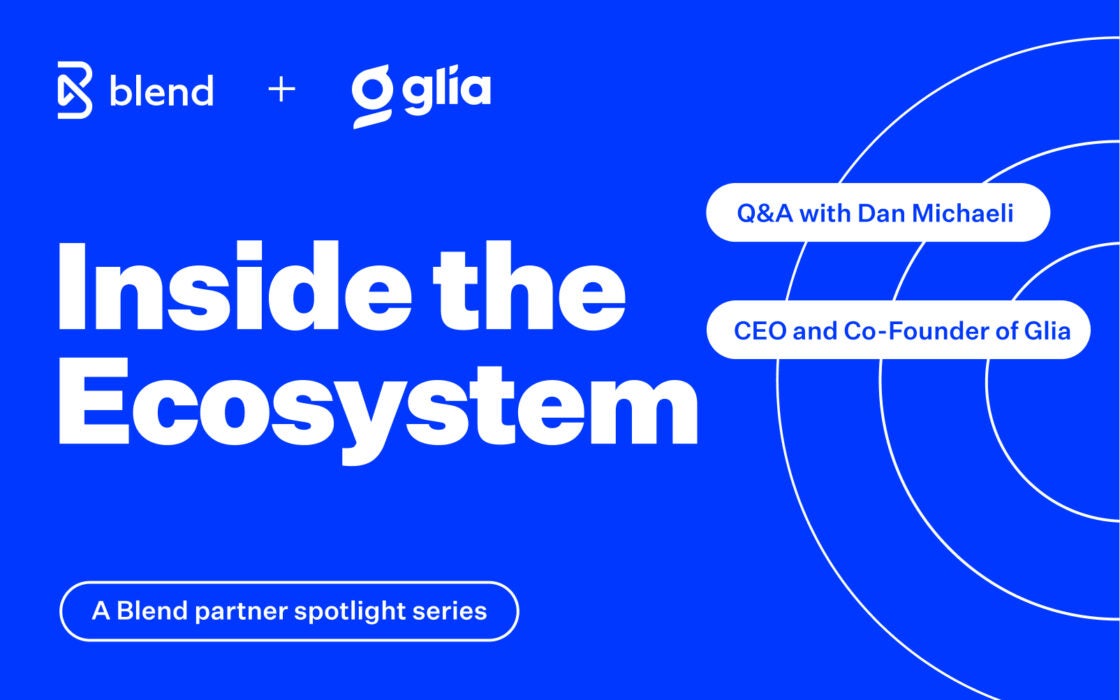May 16, 2025 in Technology partnerships
Where digital meets human: How Glia and Blend are redefining borrower support
Inside Blend’s integration with Glia: How ChannelLess® interactions and real-time assistance are helping lenders boost conversion, loyalty, and borrower satisfaction.

As digital banking evolves, today’s borrowers expect more than convenience—they want real-time, personalized support without hitting roadblocks. To explore how banks and credit unions can meet these rising expectations, we spoke with Dan Michaeli, CEO and co-founder of Glia. In this conversation, he shares what inspired Glia’s founding, why going “ChannelLess®” is more than a buzzword, and how the company’s new integration with Blend is helping lenders boost conversion, loyalty, and borrower satisfaction.
What inspired you to start Glia?
I started my career in consulting. I saw the same pattern play out time and time again during digital transformations: convenience grew, but support lagged. Companies were investing in sleek digital experiences on the front end, but when customers needed extra help, they’d hit a wall. Support was disjointed, slow and often frustrating. That disconnect was especially painful in financial services—an industry where trust and relationships are everything.
I was on-site with a major retailer known for its impressive in-person customer service when I wondered: how can we bring this same level of service to online customers? We started Glia to find out for ourselves—and prove our simple yet powerful belief that digital customer service shouldn’t be an afterthought, but rather a key component to any customer interaction. That was twelve years ago. Today, we’ve proven our belief to be true and are now facing a new frontier for banks and credit unions: the safe, responsible use of AI. We’re redefining how banks and credit unions interact with their customers, because with Glia, AI goes beyond the chatbot to be part of every interaction.
Many lenders still rely on traditional metrics like CSAT or NPS to gauge support quality—but those don’t always capture the full picture. With interactions spanning chat, phone, and digital channels—and often handled by different teams—how should financial institutions rethink what “good” actually looks like in customer support?
First, we recognize that the connection to customers goes beyond “customer support”, beyond “incident or issue resolution.” For lenders and other financial institutions, customer interactions are as much about proactively helping with conversion—like application completion—as they are solving the customer’s problems. We use “customer interactions” to account for each stage of the customer experience, from application to servicing.
In working with hundreds of financial institutions, we’ve recognized that measuring customer satisfaction alone is not enough to make direct connections to outcomes like revenue, churn rates, or customer acquisition costs.
Traditional metrics like CSAT and NPS still have an important place, but on their own, don’t demonstrate meaningful value. They capture customer sentiment about single interactions, but not how individual interactions add (or detract) from top-line and bottom-line results. What’s more powerful is visibility into how the entire interaction unfolded—across channels, across teams and in real time.
With Glia, we give our customers the ability to analyze interaction data holistically using AI: Was the interaction as efficient as possible? Where did friction occur? When did a customer switch channels and why? Was the handoff AI-enabled and seamless? These insights help institutions move from anecdotal satisfaction scores to proactive service and selling interaction design. By looking comprehensively at efficiency (lowering cost-to-serve, reducing AHT, eliminating unnecessary live interactions), effectiveness (revenue generation, increasing loan applications), and experience (CSAT, NPS, customer loyalty, customer effort), organizations can have a more modern, detailed understanding of the value of their customer interactions—by connecting interaction metrics to business-level KPIs.
One of Glia’s standout features is your ChannelLess® approach. Why is that so important in today’s customer support landscape?
It’s important because customers don’t think in channels — they just want help. Traditional contact center technology forces customers to repeat themselves as they’re transferred between teams or channels. It can be really frustrating for everyone when contact centers are siloed. Glia’s ChannelLess® approach means eliminating channel barriers and meeting customers where they are to ensure that, even if they need to switch channels to receive escalated service, the transfer is seamless on both ends and the context of the interaction is preserved.
When moving interactions between channels is easy, organizations can resolve issues faster and ensure that their customers receive the highest quality experience from the best-matched agent (human or AI) and channel (chat, voice, or video) for their unique circumstances. But more than that, we believe that effortless, unified interactions build loyalty, drive conversions and set a new standard for what service can and should be. Consumers have been “Amazon Prime-d” to expect real-time response and near-immediate service delivery. In today’s world, “good” isn’t good enough. It has to be effortless.
Your research shows that poor interactions cost U.S. businesses over $1.6 trillion a year. What can lenders do today to avoid becoming part of that statistic? And how does Glia’s new partnership with Blend help?
Negative customer interactions are expensive, and I encourage lenders to consider the long-term impacts of poor experiences: first, lost customers; then, lost relationships; and ultimately, lost lifetime value.
In lending, the key to loyalty-building interactions lies in bridging the gap between digital origination and live support. This is exactly what our partnership with Blend enables. By integrating Glia’s Digital Interactions into Blend’s platform, we empower lenders to identify customers at risk of abandoning a loan application in real-time and provide immediate assistance through their preferred channel.
For example, if a borrower has a question mid-application, they can get immediate, contextual help—whether via messaging, voice or video—without leaving the application. This creates a truly ChannelLess® experience that mirrors the personal attention of an in-branch visit, building trust and loyalty during these critical financial moments.
In an environment where loan products have become commoditized and interest rate margins are razor-thin, superior customer experience is the key differentiator. The Glia and Blend integration empowers lenders to stand out by providing instant, personalized support exactly when customers need it most. By transforming these transactions into opportunities for meaningful interactions, lenders can build lasting relationships that transcend rate-based competition.
Glia now partners with over 600 financial institutions. With that vantage point, what trends are you seeing in customer support—and which technologies or approaches do you think will become table stakes over the next few years, especially with the rise of AI?
We’re seeing more financial institutions interested in adopting AI to promote stronger customer experiences. It’s no longer nice-to-have—it’s a competitive advantage. When everyone adopts AI, what will be the new differentiator? We believe that responsible AI deployment will separate the good from the best. Ensuring chatbots don’t hallucinate, for example, will be key to providing customers with a reliable balance of AI and human support. All internal and customer facing AI tools should be purpose-built for the unique security and compliance requirements of financial services. If not, lenders risk breaking the customer trust that their business relies on. Every new technology comes with uncertainty, but when it could hurt customer relationships (the backbone of your business), you just can’t risk it.
What makes Glia’s AI responsible for lenders comes down to three core principles. First, we’ve built a secure infrastructure where your data never leaves Glia’s system and meets strict financial governance requirements. Second, we use a ‘trusted answer’ approach where all AI responses are pre-approved by the institution, ensuring there’s no unsupervised AI or risk of providing a customer with incorrect information. Third, we maintain human oversight with seamless transfers between AI and human agents when needed. In financial services, trust is everything, which is why we’ve designed our AI to be both powerful and responsible.
AI adoption is already becoming table-stakes in financial services, but deploying it responsibly and ensuring it supports an intentional balance of both AI and human interactions will differentiate any lender’s customer experience.
Want to learn more about how Blend and Glia are making real-time, personalized assistance a reality for lenders?
Blend’s Partner Ecosystem: Delivering Simplicity and Efficiency
Blend brings together over 70 top technology, data, and third-party providers in a single platform, streamlining banking experiences and eliminating friction for lenders and consumers. By continuously expanding our ecosystem with new capabilities and partners, we’re helping lenders integrate effortlessly while enhancing automation, borrower engagement, and decisioning. Visit blend.com/integrations/ to learn more.
Find out what we're up to!
Subscribe to get Blend news, customer stories, events, and industry insights.


